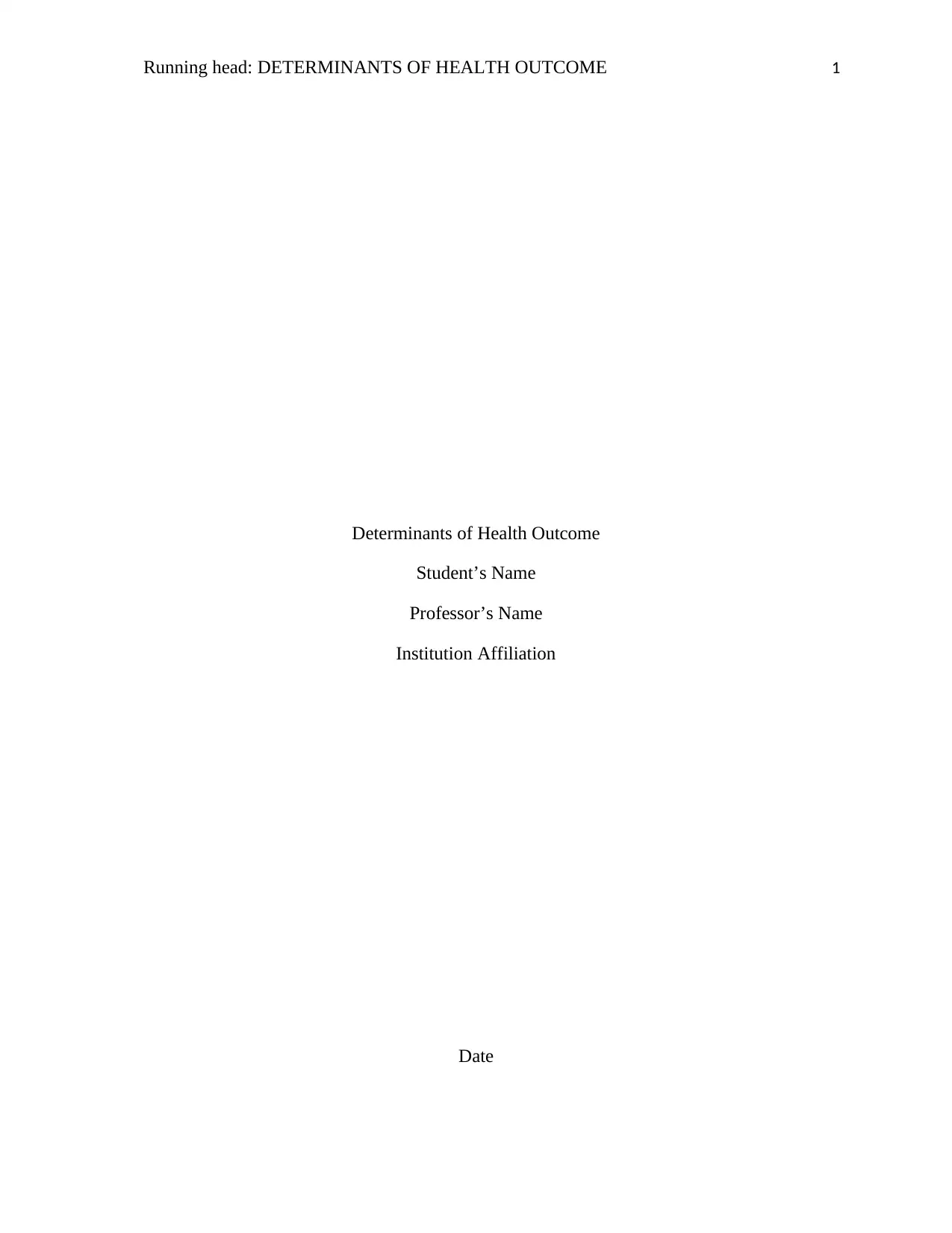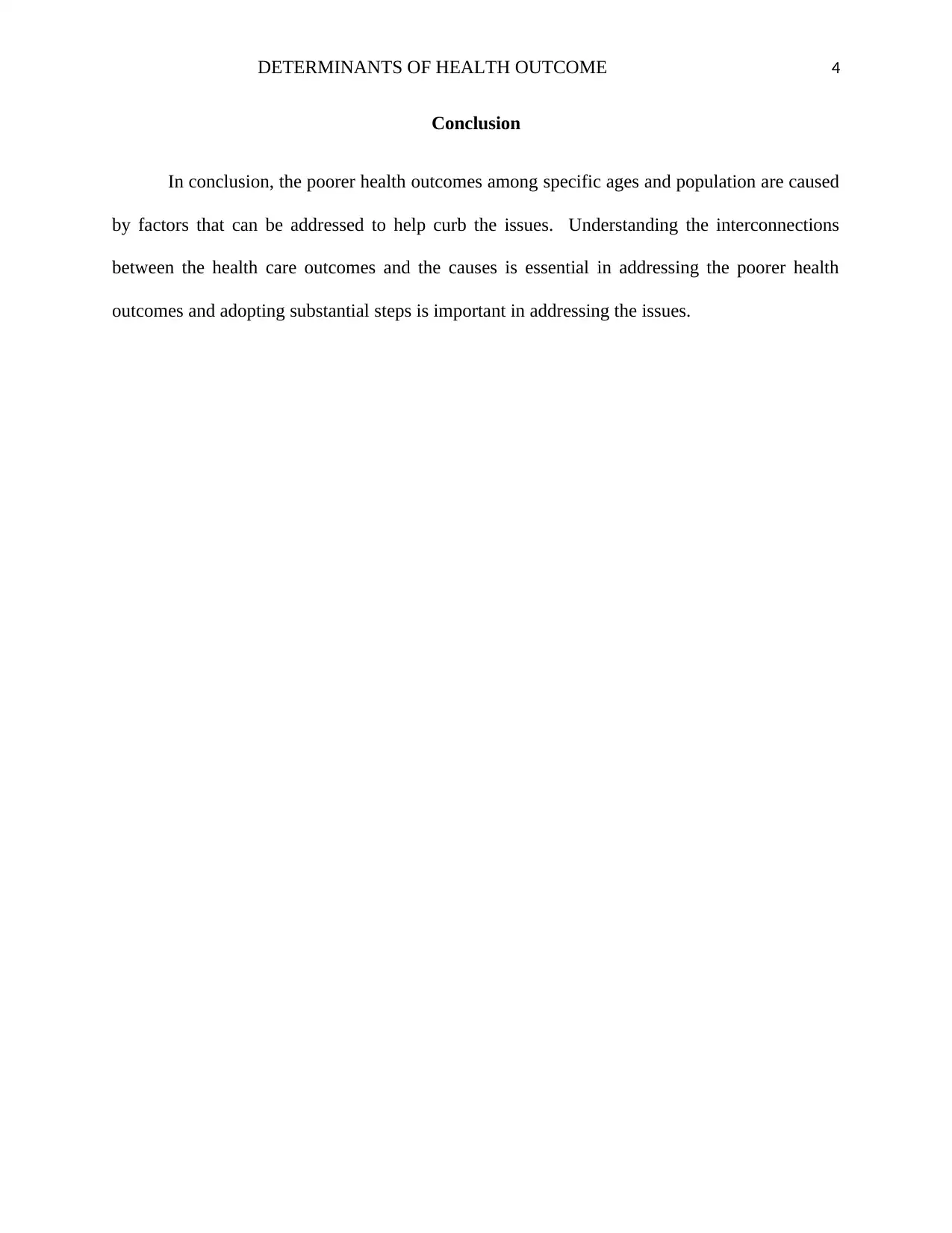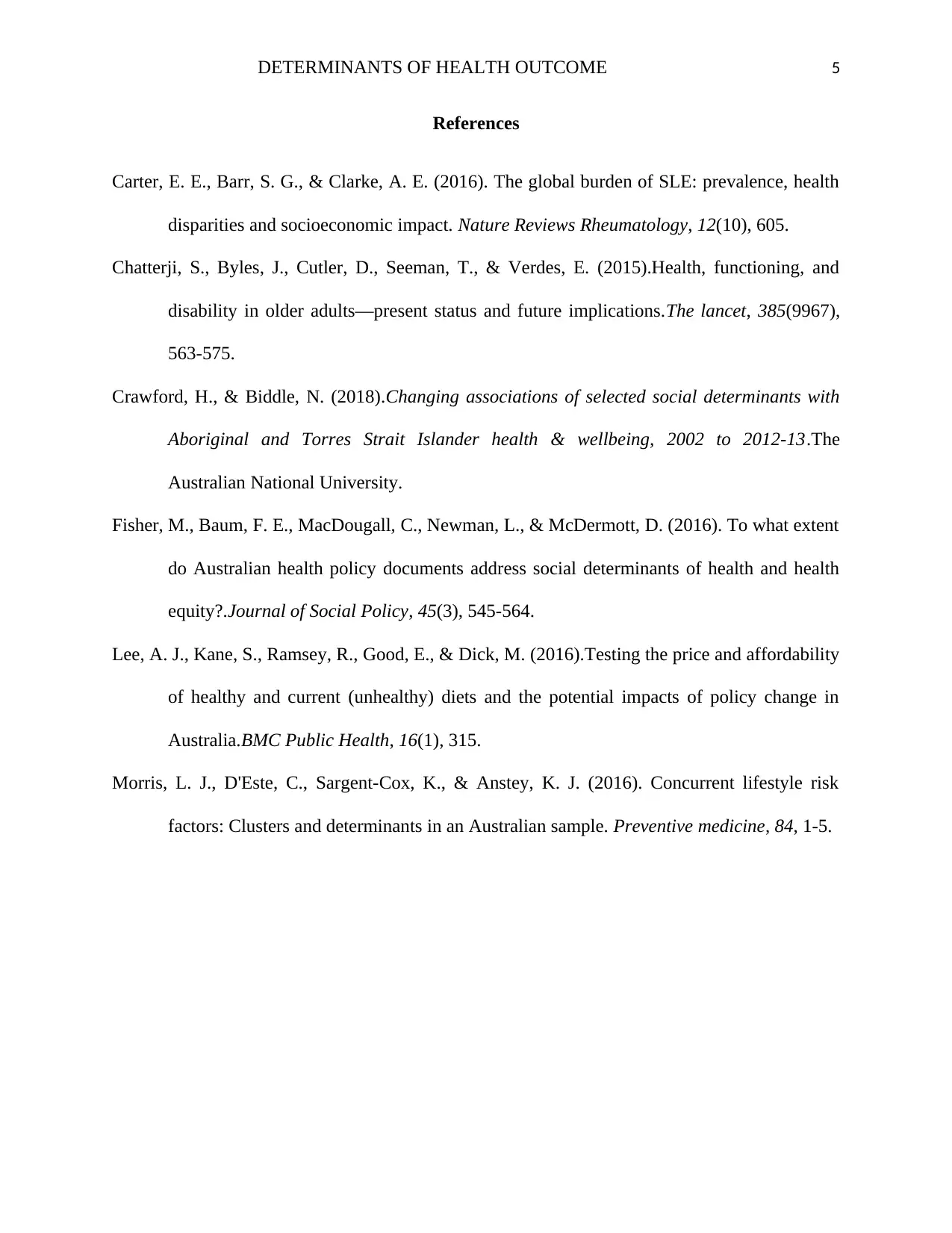Determinants of Health Outcomes: An Australian Health Essay
VerifiedAdded on 2023/01/16
|5
|948
|49
Essay
AI Summary
This essay examines the determinants of health outcomes in Australia, focusing on why certain population groups experience poorer health. It explores various factors, including socioeconomic aspects (education, occupation, income), behavioral factors among young adults (alcohol, drugs, smoking), the influences of aging (physiological changes, decreased mobility), and biomedical factors particularly affecting Indigenous Australians (chronic diseases, access to healthcare). The essay highlights the interconnections between these factors and health outcomes, emphasizing the need for targeted interventions to address health disparities and improve overall well-being across different segments of the Australian population. The conclusion stresses the importance of understanding these determinants and implementing appropriate steps to mitigate health issues.

Running head: DETERMINANTS OF HEALTH OUTCOME 1
Determinants of Health Outcome
Student’s Name
Professor’s Name
Institution Affiliation
Date
Determinants of Health Outcome
Student’s Name
Professor’s Name
Institution Affiliation
Date
Paraphrase This Document
Need a fresh take? Get an instant paraphrase of this document with our AI Paraphraser

DETERMINANTS OF HEALTH OUTCOME 2
Introduction
Even thou the bigger part of the level of individuals wellbeing and health in Australia is
relatively better comparing with the other countries, there still exist noteworthy inconsistencies
in the health outcomes among different groups in Australia. Although there exist different health
issues across the whole population and age groups, there are other health issues that tend to arise
to a specific population or life stage.
Determinants of poorer health outcomes
Socioeconomic factors
Socioeconomic aspects are an essential determinant of individual wellbeing and health in
Australia. Aspects that are involved in measuring socioeconomic position may include
education, occupation or income. It has been noted that people from lesser socioeconomic group
tend to experience an increase in the rates of diseases, higher poor health, living a shorter life,
and disability and death as compared to their counterparts from a higher socioeconomic group
(Carter, Barr & Clarke, 2016). The conditions in the lesser socioeconomic can be linked to
inadequate awareness due to the low level of education which leads to them engaging in
activities which result to poor health like drinking alcohol, smoking daily and insufficient
consumption of fruits and vegetable (Fisher, Baum, MacDougall, Newman & McDermott, 2016).
Behaviours factors among young Australians
Young adults and adolescents is a vital transition period in an individual’s life. There are
many changing risk behavioural aspects occurring that can influence the current and future
individual wellbeing and health. Young people are engaging in activities like use of alcohol and
Introduction
Even thou the bigger part of the level of individuals wellbeing and health in Australia is
relatively better comparing with the other countries, there still exist noteworthy inconsistencies
in the health outcomes among different groups in Australia. Although there exist different health
issues across the whole population and age groups, there are other health issues that tend to arise
to a specific population or life stage.
Determinants of poorer health outcomes
Socioeconomic factors
Socioeconomic aspects are an essential determinant of individual wellbeing and health in
Australia. Aspects that are involved in measuring socioeconomic position may include
education, occupation or income. It has been noted that people from lesser socioeconomic group
tend to experience an increase in the rates of diseases, higher poor health, living a shorter life,
and disability and death as compared to their counterparts from a higher socioeconomic group
(Carter, Barr & Clarke, 2016). The conditions in the lesser socioeconomic can be linked to
inadequate awareness due to the low level of education which leads to them engaging in
activities which result to poor health like drinking alcohol, smoking daily and insufficient
consumption of fruits and vegetable (Fisher, Baum, MacDougall, Newman & McDermott, 2016).
Behaviours factors among young Australians
Young adults and adolescents is a vital transition period in an individual’s life. There are
many changing risk behavioural aspects occurring that can influence the current and future
individual wellbeing and health. Young people are engaging in activities like use of alcohol and

DETERMINANTS OF HEALTH OUTCOME 3
drugs, smoking, attempts of self-harm and early pregnancies. These conditions have led to poor
health outcomes among young people in Australia (Morris, D'Este, Sargent-Cox & Anstey,
2016).
Influences of ageing
Ageing, especially in older people in Australia, is a significant determinant of individual
wellbeing and health. Ageing is associated with many physiological changes; they include
progressive loss of hearing and vision, decreased mobility and increased frailty. These poor
health outcomes can be linked to the fact that a large percentage of older people do not engage in
any physical activity. Also, some older people have been associated with malnutrition since
many tend to eat a less portion of food, and also they do not take adequate amount of vegetables
and fruits (Chatterji, Byles, Cutler, Seeman& Verdes, 2015).
Biomedical factors
There exist a lot of biomedical factors that mainly affect indigenous Australians as
compared to non-indigenous Australians. The Aboriginal and Torres Strait Islander Australians
are continuing to have some conditions like increased rate of preventable and chronic diseases,
high chances of being hospitalised, decreased life expectancy and inferior self-reported health as
compared to the non-indigenous Australians (Crawford & Biddle, 2018). These conditions are
associated with a decrease in the quality of housing, difficulties in accessing culturally approved
and affordable health services. Also, increased risks factors like increased rates of alcohol
consumption and smoking, lack of adequate exercise and increased rates of hypertension, blood
sugar and blood lipids are factors that pose a risk to health to indigenous Australians (Lee, Kane,
Ramsey, Good & Dick, 2016).
drugs, smoking, attempts of self-harm and early pregnancies. These conditions have led to poor
health outcomes among young people in Australia (Morris, D'Este, Sargent-Cox & Anstey,
2016).
Influences of ageing
Ageing, especially in older people in Australia, is a significant determinant of individual
wellbeing and health. Ageing is associated with many physiological changes; they include
progressive loss of hearing and vision, decreased mobility and increased frailty. These poor
health outcomes can be linked to the fact that a large percentage of older people do not engage in
any physical activity. Also, some older people have been associated with malnutrition since
many tend to eat a less portion of food, and also they do not take adequate amount of vegetables
and fruits (Chatterji, Byles, Cutler, Seeman& Verdes, 2015).
Biomedical factors
There exist a lot of biomedical factors that mainly affect indigenous Australians as
compared to non-indigenous Australians. The Aboriginal and Torres Strait Islander Australians
are continuing to have some conditions like increased rate of preventable and chronic diseases,
high chances of being hospitalised, decreased life expectancy and inferior self-reported health as
compared to the non-indigenous Australians (Crawford & Biddle, 2018). These conditions are
associated with a decrease in the quality of housing, difficulties in accessing culturally approved
and affordable health services. Also, increased risks factors like increased rates of alcohol
consumption and smoking, lack of adequate exercise and increased rates of hypertension, blood
sugar and blood lipids are factors that pose a risk to health to indigenous Australians (Lee, Kane,
Ramsey, Good & Dick, 2016).
⊘ This is a preview!⊘
Do you want full access?
Subscribe today to unlock all pages.

Trusted by 1+ million students worldwide

DETERMINANTS OF HEALTH OUTCOME 4
Conclusion
In conclusion, the poorer health outcomes among specific ages and population are caused
by factors that can be addressed to help curb the issues. Understanding the interconnections
between the health care outcomes and the causes is essential in addressing the poorer health
outcomes and adopting substantial steps is important in addressing the issues.
Conclusion
In conclusion, the poorer health outcomes among specific ages and population are caused
by factors that can be addressed to help curb the issues. Understanding the interconnections
between the health care outcomes and the causes is essential in addressing the poorer health
outcomes and adopting substantial steps is important in addressing the issues.
Paraphrase This Document
Need a fresh take? Get an instant paraphrase of this document with our AI Paraphraser

DETERMINANTS OF HEALTH OUTCOME 5
References
Carter, E. E., Barr, S. G., & Clarke, A. E. (2016). The global burden of SLE: prevalence, health
disparities and socioeconomic impact. Nature Reviews Rheumatology, 12(10), 605.
Chatterji, S., Byles, J., Cutler, D., Seeman, T., & Verdes, E. (2015).Health, functioning, and
disability in older adults—present status and future implications.The lancet, 385(9967),
563-575.
Crawford, H., & Biddle, N. (2018).Changing associations of selected social determinants with
Aboriginal and Torres Strait Islander health & wellbeing, 2002 to 2012-13.The
Australian National University.
Fisher, M., Baum, F. E., MacDougall, C., Newman, L., & McDermott, D. (2016). To what extent
do Australian health policy documents address social determinants of health and health
equity?.Journal of Social Policy, 45(3), 545-564.
Lee, A. J., Kane, S., Ramsey, R., Good, E., & Dick, M. (2016).Testing the price and affordability
of healthy and current (unhealthy) diets and the potential impacts of policy change in
Australia.BMC Public Health, 16(1), 315.
Morris, L. J., D'Este, C., Sargent-Cox, K., & Anstey, K. J. (2016). Concurrent lifestyle risk
factors: Clusters and determinants in an Australian sample. Preventive medicine, 84, 1-5.
References
Carter, E. E., Barr, S. G., & Clarke, A. E. (2016). The global burden of SLE: prevalence, health
disparities and socioeconomic impact. Nature Reviews Rheumatology, 12(10), 605.
Chatterji, S., Byles, J., Cutler, D., Seeman, T., & Verdes, E. (2015).Health, functioning, and
disability in older adults—present status and future implications.The lancet, 385(9967),
563-575.
Crawford, H., & Biddle, N. (2018).Changing associations of selected social determinants with
Aboriginal and Torres Strait Islander health & wellbeing, 2002 to 2012-13.The
Australian National University.
Fisher, M., Baum, F. E., MacDougall, C., Newman, L., & McDermott, D. (2016). To what extent
do Australian health policy documents address social determinants of health and health
equity?.Journal of Social Policy, 45(3), 545-564.
Lee, A. J., Kane, S., Ramsey, R., Good, E., & Dick, M. (2016).Testing the price and affordability
of healthy and current (unhealthy) diets and the potential impacts of policy change in
Australia.BMC Public Health, 16(1), 315.
Morris, L. J., D'Este, C., Sargent-Cox, K., & Anstey, K. J. (2016). Concurrent lifestyle risk
factors: Clusters and determinants in an Australian sample. Preventive medicine, 84, 1-5.
1 out of 5
Related Documents
Your All-in-One AI-Powered Toolkit for Academic Success.
+13062052269
info@desklib.com
Available 24*7 on WhatsApp / Email
![[object Object]](/_next/static/media/star-bottom.7253800d.svg)
Unlock your academic potential
Copyright © 2020–2025 A2Z Services. All Rights Reserved. Developed and managed by ZUCOL.




